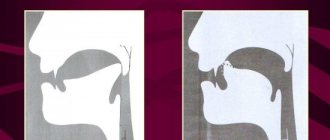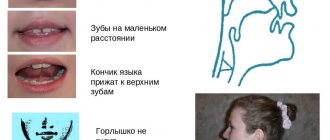What prevents you from pronouncing R?
The articulation of this phoneme is the most complex in Russian speech. For correct sound, clear movements of the speech apparatus are required, which are quite difficult for children. To make their task easier, children “swallow” the phoneme in words, replace it with the sounds “L” and “Y” that are simpler in terms of articulation, or use glottal phonation.
Causes of the problem:
- pathological bite;
- speech breathing defect;
- underdevelopment of the lingual frenulum;
- weakness of the facial muscles;
- distorted perception of sounds.
Staging is assigned when the sound “R”:
- is missed in words;
- replaced by the phonemes “L” and “Y”;
- softens where it should be hard.
Reasons for incorrect pronunciation
Factors that cause mispronunciation are:
- Pathological bite. Moving forward the upper or lower jaw. In this case, you should go to the dentist.
- Respiratory dysfunction. The growl is produced by vibrations with the tip of the tongue resting on the roof of the mouth next to the upper teeth. Vibration occurs when air is exhaled. If the exhalation is weak, the air does not vibrate, making proper sound impossible.
- Incorrect structure of the lingual frenulum. For a clear sound, it is necessary that the tongue rises to the upper teeth. If the frenulum is short, then this is problematic. A normal frenulum should be 8 mm long, and a short frenulum is either lengthened surgically or developed through exercises.
- Undeveloped speech apparatus. To understand that the child’s tongue, labial, and jaw muscles are weak, the parent asks him to perform simple movements: fold his lips into a tube, smile broadly, stretch out his tongue strongly, reach the corners of his mouth with his tongue. If there are problems completing the task, then the facial muscles are weak. A consultation with a neurologist is needed, since dysarthria can be a consequence of severe nervous pathologies.
- Impaired speech hearing. Children begin to clearly perceive phonemes by ear by the age of 4 years. If there are hearing problems, then phonemes in spoken words are either skipped or replaced.
- Behavioral disorders. Making sounds is problematic in children with hyperactivity and attention deficit disorder.
What specialist help may be needed?
If the cause of a speech defect in a child is a shortened hyoid frenulum, then consultation with a surgeon may be required. But in modern speech therapy they solve this problem with the help of exercises. And only those who have a too short frenulum need the help of a surgeon. This defect makes it difficult to raise the tongue, which is the basis for the pronunciation of R.
If your bite is incorrect, your speech therapist may advise you to see an orthodontist. If there is a complex speech disorder (dysarthria, alalia), to activate speech processes you need a special course of treatment, which is selected by a neurologist. As well as a consultation with a defectologist who can draw up a plan for corrective work on the development of the emotional-volitional sphere.
Staging exercises
First, a warm-up session is carried out:
- The mouth stretches into a smile and opens slightly. The tongue strokes the palate from the upper dentition to the uvula. Repeat 10 times.
- The mouth opens and stretches into a smile. The tongue sticks out and swings like a pendulum. Repeat 20 times.
- The mouth opens in a smile. The tongue is pressed against the palate as when pronouncing a softened “N”. With this position of the tongue, the mouth opens and closes widely. Repeat 20 times.
- The mouth opens in a smile. The tip of the tongue moves along the inside of the upper dentition to the right and left. Repeat 10 times.
- The mouth opens. The tip of the tongue goes beyond the incisors with a long pronunciation of “Z”. Then it is moved into the mouth, pressed against the palate near the upper teeth, pronouncing “Z”.
Then you can begin the main training. Methods for setting the sound R:
- Through "D". The mouth opens, the tip of the tongue is pressed against the back surface of the upper dentition with a quick and clear pronunciation of “D”. Next, pronounce “D” while exhaling deeply. Gradually, language vibration should develop.
- Through “F” using a speech therapy spatula. The mouth opens wide with a pulling “F”, while the tongue gradually moves to the back wall of the upper dentition. A spatula is carefully placed under the tongue and moved to the right and left sides to create vibration.
- Through "Z". The mouth opens, the tongue moves in deeply, and a “zz” sound is made. A spatula is placed under the tongue and moved to the right and left side. The production of the soft sound “R” through “Z” is similar, but it is pronounced “z-zi”.
The main exercise that allows you to put a phoneme is called “Motor”.
The tongue is pressed against the palate and a finger is placed under it. It is necessary to forcefully push out the air while pronouncing a long “D” or “F”. At the same time, make quick oscillations with your finger under your tongue from right to left. With this method, the placement of the throat sound “R” is corrected, and it is the tip of the tongue that vibrates in a relaxed state.
The phoneme “Рь” appears independently after the solid sound has been consolidated. For a soft sound, the consonant is used with the vowels “I”, “Yu”, “E”, “I”, smiling widely.
The sound P is produced mechanically using a small stick. A long “Z” sound is pronounced, and under the tongue the stick quickly moves left and right. The result of the mechanical impact is a rolling growl.
Introduction to Speech
Eliminating incorrect pronunciation is a long process and takes time. On average, it takes up to a year to correct the defect. The help of parents also plays a big role. If they are interested, they will study daily.
Adults can also be burry. And the same methods of sound production apply to them. It will take serious motivation to cope with a speech impediment.
Sometimes parents do not understand why they should force their child to speak correctly. His future career depends on this. Many professions have standards and people with defects will not be hired.
It will take a long time to introduce sound into speech. At this stage, it is important to engage self-control. It is necessary to correct the child, force him to remember the correct pronunciation. It is useful to learn rhymes, simple sayings, tongue twisters.
Correction of any defect directly depends on the coordinated work of a specialist and parents. Only together can they cope with the problem. The faster a child learns articulatory gymnastics and begins to perform it perfectly, the sooner a sound will be given to him.
Articulation gymnastics for the sound R
Staging the pronunciation of the sound P is carried out in stages, the initial and important stage is gymnastics, which prepares the speech organs for the main staging complex. A home method of stimulating the speech apparatus involves using a mirror or imitating the patient pronouncing correctly. Trainings are held daily, but not for long, so that the preschooler does not get tired or lose interest.
When the sound P is produced in stages, gymnastic exercises allow you to increase the exhalation of air, stretch the frenulum, and strengthen the lingual muscles.
- "Swing". The mouth opens, the tongue sticks out, swings up and down, touching the teeth. Stops on the upper teeth for 10 seconds.
- "Sweet jam." The tongue licks the lips, first clockwise, then counterclockwise.
- "Turkey". The mouth opens slightly. The tongue slides in both directions along the upper lip without leaving it. The movements accelerate, and you need to try to say “bl-bl-bl.”
- "Artist". The tongue, like a brush, licks the teeth, palate, and inner surface of the cheeks.
- "Punishment". The tongue protrudes from the oral cavity, is compressed with quick movements by the lips while exhaling air.
- "Horse". The tongue clicks across the roof of your mouth, imitating the sound of horse hooves.
- "Fungus". The tongue is pressed against the palate and held for 10 seconds. The elongated frenulum looks like the stem of a mushroom.
general information
Parents may not always correctly notice distorted pronunciation. It is formed for various reasons. Most often the problem is in the short hypoglossal ligament. It attaches the tongue to the oral cavity and if it is not long enough, the mobility of the organ is limited.
The following congenital anatomical features may also be observed:
- high sky;
- narrow sky;
- massive tongue.
Sometimes replacing the front milk teeth with molars can take a long time and this will lead to incorrect pronunciation. Somatically weakened children who often suffer from colds may experience weak breathing and lethargy. Their tongue will move and rise poorly. Due to the lack of a strong air stream, it will not be possible to cause vibration.
Another reason for throaty pronunciation is early learning of a foreign language.
Some parents, from the age of three, begin to teach their child French or English, without taking into account the difference between the pronunciation of sounds.
Correcting such a defect will take a lot of time. It's easier to add sound when it is completely absent from speech. If it is pronounced distortedly, then you will have to make a lot of effort to correct the situation.
Throat pronunciation is difficult to correct due to insufficient development of phonetic-phonemic perception. The child gets used to hearing the defective sound and cannot distinguish it from the normal one. Therefore, attempts to introduce the correct sound into speech may end in failure.
Speech breathing
In order for the phoneme to sound correctly, the air stream must be directed correctly. If the air flow is incorrect, a throaty type of sound is formed, also called “French”. Therefore, techniques for producing the sound P include breathing training.
The following exercises are suggested for producing the sound R in children:
- "Candle". An ordinary candle is lit. She needs to be blown out. They blow either so that the fire goes out immediately, or so that it fluctuates but does not go out. During the training process, the candle is gradually moved away from the mouth so that the blowing becomes heavier.
- "Hurricane". Take a glass of water and a straw for drinking liquids. Inhale air through your nose and exhale through your mouth into a tube lowered into water. Seething appears on the surface of the water.
- "Snowflake". They open their mouth, smile broadly, and place their tongue on the lower lip. And a piece of paper is placed on the tongue. This piece of paper needs to be blown away.
Each action is repeated no more than 4 times. An important condition for an effective process is nasal inhalation and oral exhalation.
Producing the sound “r” in adults
Speech therapy classes for producing the sound “r” in adults include:
- deep breathing technique using the diaphragm;
- exercises aimed at developing the muscles of the tongue and lips.
The breathing technique is as follows:
- inhale through your nose, protruding your stomach and filling the lower sections of your lungs with air;
- exhale, contracting your abdominal muscles and forcing a powerful stream of air through your vocal cords.
Exercises for pronouncing the letter “r” are aimed at “stirring up” the tongue: bite it, click it, stretch it, twist it, perform transverse turns and circular movements.
And, of course, tongue twisters - their importance is difficult to overestimate. Unlearn, repeat and praise yourself for your success.
To learn how to pronounce “r” for an adult, it may take more time than for a child, so an attitude towards results is important. And when there is motivation, the process goes much faster.
Speech hearing
A very common problem with impaired speech hearing is the replacement with “L”. In this case, the peculiarity of staged training is the alternation of the correct and replacement phonemes in words. The student must learn to distinguish between these sounds at the beginning, middle, and end of a word.
The speech therapist pronounces the words: mosquito, milk, hand and the like. The patient must answer which spoken words contain “R”. The vocabulary chain can include words with consonants combined with a problematic phoneme: laurel, thunder, and others.
Combinations that are difficult for children’s speech apparatus require special development:
- DR. First they pronounce the long “D”, then add a vibrating “rrrr”: friend, fight, bucket.
- T-R. Coward, pipe, trolleybus.
- Z-R. Vision, congratulations, hello.
Automation of sound R
The stages of producing the sound P include automation - a technique that consolidates skills. The sound of the phoneme is fixed in a variety of words containing the problematic letter, phrases, you can use a poem or tongue twister. First, the phoneme needs to be automated in conjunction with vowels and consonants, then in words and sentences.
Automation of the P sound in syllables
Practice is carried out through the consonants “D” and “T”, syllables with a combination of “dr” and “tr” are used: “dra” and “tra”, “dro” and “tro”, “dru” and “tru”. Through these consonants it will be easier for the language to move to the problematic phoneme.
Then the front consonants are removed, leaving the syllables “ra”, “ro”, “ru”. The training takes place in stages, then you need to introduce inverted syllables: “ar”, “or”, “ur”. It is necessary to alternate syllables until the vibratory sound is established in the patient.
Automation of the sound R in words
Once the syllables have been mastered, you can move on to words. You should start with words in which the problematic phoneme is in the initial syllable: river, pipe, shirt. Then comes the study of words in which the phoneme is in the middle or last syllable: tomato, cow, motor.
Next, you need to work on the softened sound in words. With a normal growl, the tongue is pressed tightly to the palate and is located almost right next to the teeth; with a softened growl, it is not pressed so tightly and is located a little further from the upper row of teeth.
Usually, after several trainings, children themselves begin to understand the difference between normal and softened sounds, and use this difference when pronouncing words. Some children need to be explained that the tongue needs to be moved a little deeper across the roof of the mouth.
Duration of correctional work
How long does it take to develop the correct pronunciation of the sound R? In modern speech therapy there are no clear time boundaries. This applies to working with any group of sounds. It all depends on the individual characteristics of the child. You can install sound already in the first lessons (if preparatory work has been done), but the automation stage can take quite a long time.
The sound R is complex in articulation, which is why it appears in speech at an older age. There is no need to rush into automation; your task is to achieve clear sound and stable vibration. The tongue should not “slip” when the child pronounces words. To make it interesting for him, use didactic games, and not just verbal and visual material.
You can look for a specific speech therapy technique, but they are all built on the principles and practical tips outlined above. The main condition for successful correctional work is diagnosis and correctional work taking into account the individual characteristics of the child.
Consolidate the result
After the main speech therapy process, the training does not end. At home, parents can teach their children themselves. Children in the preschool period are bought books with speech therapy rhymes and songs, special games, cubes or pictures with drawn objects whose names contain problematic sounds.
Such games develop not only speech, but also thinking abilities. When you go for a walk with your baby, you can ask him to name the objects he meets along the way, the content in the name is the phoneme being practiced.
It is helpful for a teenager with a speech problem to read poems and stories aloud. You can invite him to compose and tell his own stories to develop his thinking.








